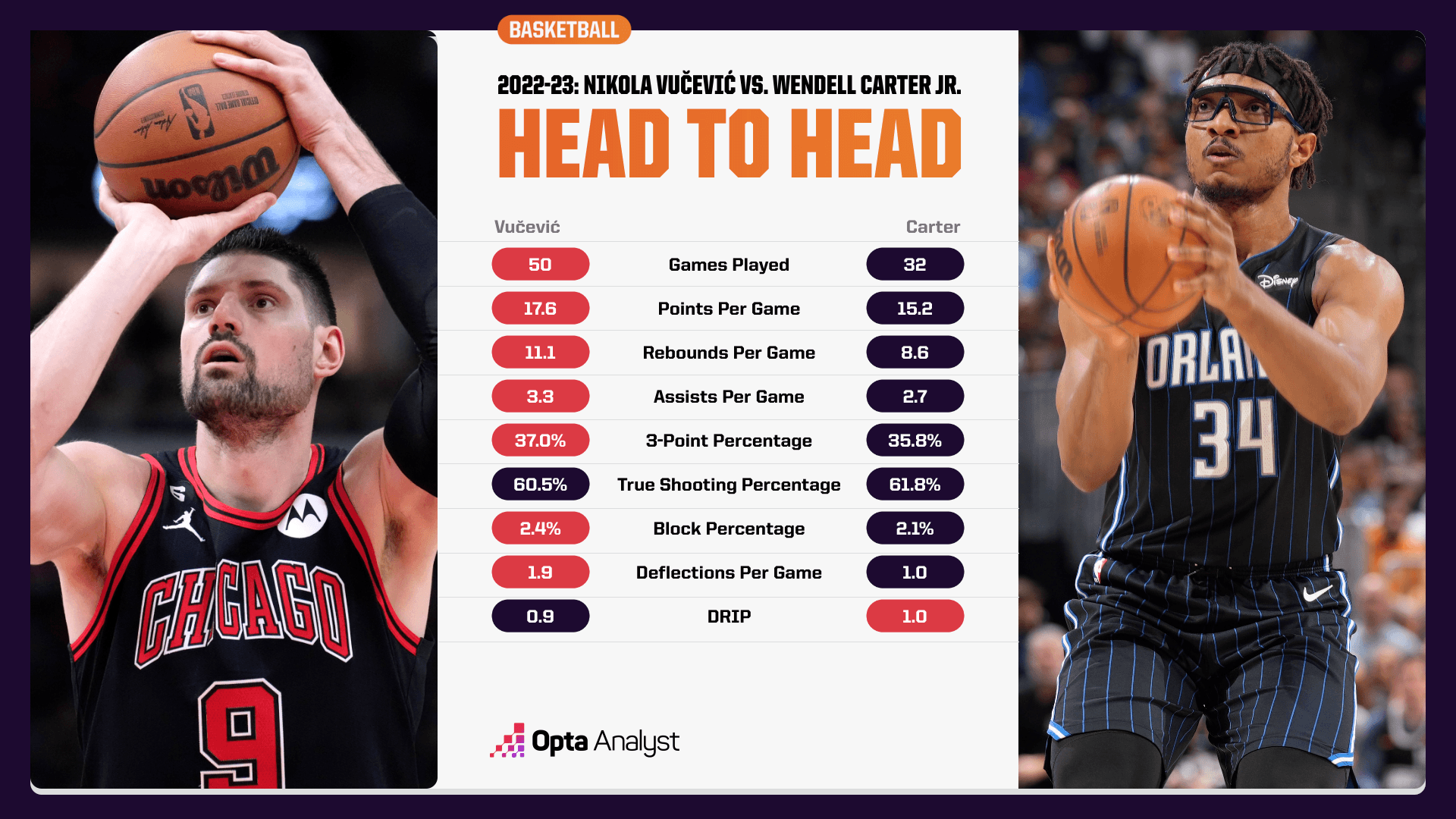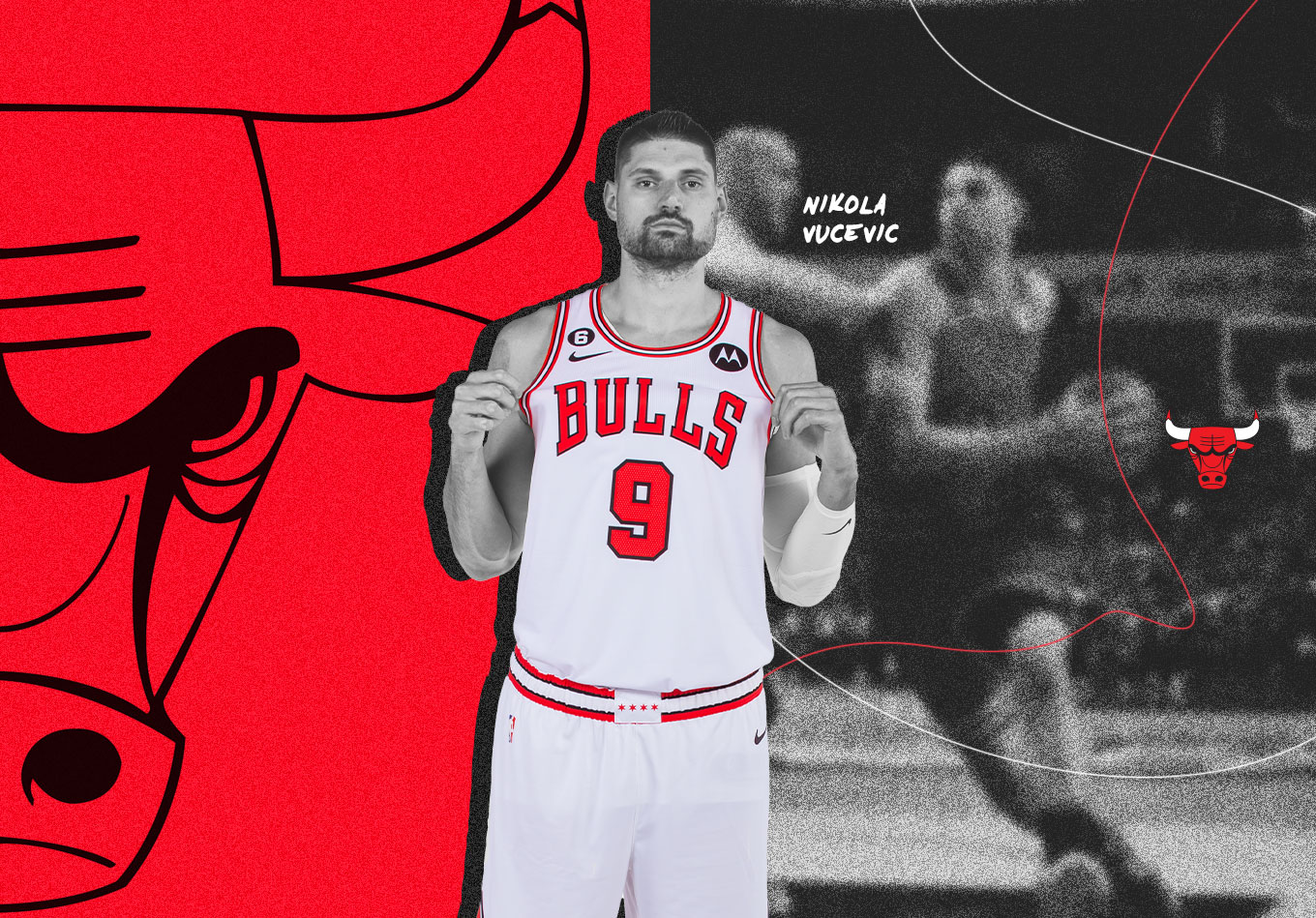When the Chicago Bulls matched up with the Orlando Magic on a Saturday evening in late January, it was more than just a clash between conference conglomerates. It was the return of the Magic’s third all-time leading scorer to his original stomping grounds.
Roughly two years ago, the Bulls authored a deadline deal that sent Wendell Carter, Otto Porter Jr., and two first-round picks to Orlando in exchange for Al-Farouq Aminu and the man of the hour, Nikola Vučević.
Since then, the deal has been heavily scrutinized. And while it is difficult to fathom the draft capital sacrificed, a deeper examination of Vučević’s performance this year proves the deal is not nearly as lopsided as the critics claim.
This season, Vucevic is averaging 17.6 points, 11.1 rebounds and 3.3 assists on 60.5% true shooting (2.6% better than league average). Even more impressive, he’s put up 20.3 points, 13.1 boards and 4.4 assists per game on the same true shooting percentage since the calendar turned to 2023.
Vučević represents a rare and difficult-to-evaluate player type in the NBA. He stems from the same root as unicorns like Nikola Jokić and Domantas Sabonis. He’s not a menacing rim deterrent or versatile switch defender, but he’s a dynamic offensive player whose abilities present a myriad of problems for opponents.
A perfect way to contextualize the issues defenses face when battling an opponent of his caliber is to think of the three main ball-screen coverages used today: switching, trapping/hedging, and dropping/ICE.
In this era of small ball and positionless basketball, switching has become all the rage, with elite defenses like the Boston Celtics and Miami Heat both deploying aggressive switch-heavy schemes.
This coverage choice is great because it allows teams to contain the action to a 2-on-2 endeavor (like we examined with Nic Claxton). However, this advantage becomes a disadvantage when the screen involves Vučević.
Few players have the necessary girth to battle with Vučević in isolation. Knowing this, Chicago often sets ball screens with the hopes of seducing said switch. Once this happens, the ball handler immediately looks to Vučević for the mismatch post-up on the interior.
You’ll recall from our analysis of Luka Dončić’s game that one of the factors that makes a post-up possession efficient in the modern game is if said back down is being performed against a mismatch. Thanks to Vučević’s robust build, most matchups present this incongruity.
On the season, he’s in the 93rd percentile in post-up volume and 78th percentile in post-up efficiency (per NBA.com). Among the players in the top 10 in post-ups per game, he’s third in efficiency behind only the aforementioned Jokić and his second fiddle in the last two MVP races, Joel Embiid.
Chicago touts two dynamic on-ball scorers in DeMar DeRozan and Zach LaVine. And because of their splendor, defenses will regularly trap/hedge them in order to compel them into giving up the ball, thereby forcing someone else on the roster to beat them.
The tactic makes great sense in theory. You want to keep the ball out of the hands of your opponent’s best player(s). A fair hypothesis, but the theory gets sullied in practice when the person they are giving up the ball to is Vučević.
Whenever a ball handler is trapped on a pick-and-roll and dishes the ball out to a rolling screener, that situation is what is known as a short roll. In this setting, the roller who gets the ball is blessed with a 4-on-3 advantage until the other defender recovers back to his original assignment (watch any Golden State Warriors game and you are almost guaranteed to see this sequence play out between Stephen Curry and Draymond Green).
To thrive in this environment, the roller needs to excel in two areas: passing and quick decision-making. And as you’ll see in the following montage, Vučević has both of these requisite skills down pat:
Of the 74 players averaging 17 or more points per game this season, Vucevic has the lowest average seconds per touch (1.46) – a strong indicator of swift and decisive decision-making.
And while he isn’t the dime dropper that Jokić and Sabonis are, the list of centers that are definitively better passers than Vučević is scarce.
Okay, so switching and trapping don’t project well against Vučević. What about dropping/ICEing?
While the two techniques have some notable differences, both involve having the big man drop back to protect the paint. Among other things, this maneuver protects against rollers and mismatch post-ups. The kicker is that it does leave the defense vulnerable to the pick-and-pop.
Last season, when the Milwaukee Bucks played the Bulls in the first round of the playoffs, they ICE-ed both DeRozan and LaVine, betting Vučević wouldn’t be able to make them pay from downtown. Lo and behold, the gamble paid off as the Swedish big man shot 31.0% on his 8.4 attempts in the series.
So why are we mentioning this to argue on his behalf?
Great question. Last season in general was a tough shooting year for Vučević. For the entire 2021-22 season, he shot 31.4% from 3 and 44% from the midrange. This season, he’s converting 37.0% of his triples and a DeRozian 52.8% of his midrange jumpers.
He’s regained his touch, which is a strong sign that, if the Bulls do make the playoffs again, old tricks (first play below) won’t work this time (second play).
Turning the page to his defense, like Jokić and Sabonis, just because he isn’t an NBA Defensive Player of the Year candidate doesn’t mean he doesn’t have some value on that end.
When the action involves him, the Bulls typically tend to defend screens at the level. At the level coverage isn’t as popular as the defensive layouts we’ve discussed because of the degree of difficulty it requires to pull it off correctly. However, if you can manage it, it’s extremely effective because it combines concepts from the three styles we’ve examined so far.
To be a good at-the-level big man, you need to have good hands. This is because once the ball handler makes the pass to a teammate, the defense needs to scramble a ton. More scrambling means more opportunities for breakdowns. So if your big can just steal/deflect the initial pass, it saves you from making the mistake in the first place.
Vučević is currently sitting at 1.9 deflections per game, placing him in the 89th percentile among centers.
Chicago ranks fifth in the NBA in our adjusted defensive rating metric behind only the Memphis Grizzlies, Heat, Cleveland Cavaliers and Bucks. And since centers are the players that generally impact defense the most, Vučević (at the very least) projects as a capable defender.
Back to that Saturday showdown with the Magic. A common take many of Vučević’s naysayers have had since the deal is that Carter on his own is already a superior player. The ironic thing about those statements is that during that game Vučević posted a points/rebounds/assists stat line of 26/13/5, while Carter was relegated to the bench for the entirety of the final stanza.
Now, don’t get us wrong, Carter is a talented young big in his own right, but his numbers this season do not point to him as being a clearly better contributor than Vučević. In fact, Vučević has outperformed in a multitude of categories across the board.

And when you factor in that he has played in 18 more games than Carter, it is fair to say that Vučević has actually been the more valuable player between the two this year.
Let’s face it, with Franz Wagner (one of the picks Chicago traded away) emerging as one of the best players in the 2021 NBA Draft, the deal will never be perfect. But for people to say that Vučević has been bad or negative to his team is disingenuous. He’s been one of the best offensive centers in basketball and an impactful defender within his team’s scheme.
Historically speaking, these two statements usually make up the ingredients of a top-50 player in the NBA.
